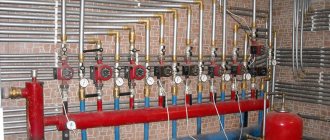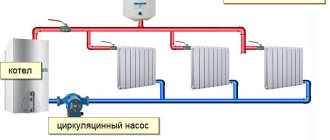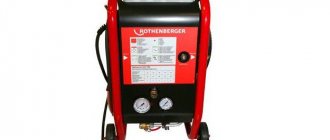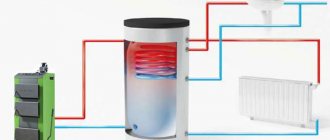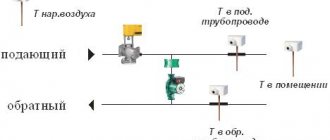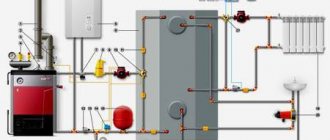Heating system of an apartment building
Central heating systems for apartment buildings were created in accordance with the projects. Therefore, you can literally learn everything about heating an apartment and the entire house if you find the project and understand it down to the last screw.
Next, we will consider what heating solutions are usually used in apartment buildings, and how they affect the quality of heating in apartments. And also how issues related to the repair and operation of pipes, batteries and the entire centralized heating system of a high-rise apartment building are resolved in practice
Why are you interested in the heating scheme of a high-rise building?
The heating system of a multi-storey building can be of concern in several cases, for example:
- When replacing a radiator in an apartment, the question arises - how to turn off the riser, what kind of radiator can be installed and what is the best way...
- If you change the riser, what pipes can be used?
- When the heating is not working well, it is natural to ask why? - maybe you can adjust it, even on your own...
- If you want to organize your own boiler room together with other residents, then how to do it...
- When installing a heat meter, where in the system should it be installed?
But without the approval of the housing office, no action with centralized heating. And such actions are usually performed only by specialists of the same service organization.
What schemes are found in apartment buildings
Projects for heating entire areas from a central heating station are always individual and depend on the housing stock. Usually one boiler house was built per microdistrict, but this is not the rule; very large thermal power plants and small boiler houses were built.
But heating distribution in high-rise buildings built in Soviet times is, as a rule, standard. Single-pipe radiator connection schemes were used, where one pipe was a vertical riser. The risers, of which there were many per house, were connected in parallel to the heating supply main, and thus found themselves in approximately the same hydraulic conditions.
An approximate diagram of a vertical single-pipe is shown in the figure. Please note that there are up to 18 radiators on one pipe.
The correct radiator connection diagrams are using a parallel bypass.
Connection diagram for a radiator in an apartment with single-pipe wiring throughout the house.
Disabling one radiator (drip!) will not affect heating in other apartments due to the presence of a bypass. In addition, the balancing valve allows you to dim the radiator at will.
But single-pipe systems have a known drawback - the last radiators in the ring are cooler. How did you deal with this?
Features of heating in apartment buildings
To prevent radiators on the top floors from being too cold, a high coolant flow rate must be set along the riser, which equalizes the supply and return temperatures. In centralized heating systems, they were able to make sure that the temperature in the riser was without a significant difference for users. And no one struggled with increasing the area of radiators to equalize heat transfer.
- A centralized heating system is characterized by high coolant flow rates, to the point where noise occurs in the pipes. Hence the high pump power and high pressure drop.
- The second feature is the high total pressure in the system. Filling was carried out from the bottom point, and in order to raise the coolant to the 9th floor it was necessary to create the appropriate pressure, up to 12 atm.
- The next feature is the high temperature of the coolant - poor thermal insulation, heat leaks, wastage of energy resources, which often allowed utility companies to solve the problems of “heat in homes” by simply increasing the flow rate and increasing the temperature above the norm, even above 100 degrees C at increased pressure.
All this places its own demands on radiators and pipes.
What pipes and radiators should be used in a multi-storey building?
All high-rise buildings in Soviet times were equipped with steel pipes and cast iron radiators. Now there is a choice. Other types of pipes and radiators are more practical, cheaper, and more durable.
But making your own choice when replacing a radiator in an apartment without consulting the housing office is unacceptable. Moreover, dismantling the riser and changing pipes is something only specialists will do.
Basically, Zhekovsky specialists solder PN30 foam propylene 25 mm (outer diameter) with aluminum reinforcement, despite the fact that its maximum temperature is still +95 degrees, and in the central line it can be more... Now PN25 with similar characteristics have already appeared.
It is also possible to use metal-plastic pipes to connect radiators in a multi-storey building - according to the decision of the network maintenance service. The diameter used is generally 20 mm (outer).
When replacing a radiator, the utility workers will definitely oblige you to create a circuit with a shutdown using two taps and a bypass parallel to the radiator.
When replacing a radiator in an apartment
- The model and dimensions (heat output) of the radiator are agreed with the specialists of the service organization.
- The riser is turned off and the liquid is drained.
- Usually old steel pipes are cut off, since it is not possible to unscrew the threaded connections. More often, radiators are replaced along with pipes; the types of pipes used are also agreed upon with the housing office.
- The radiator is hung on a standard mount and is equipped with plugs, ball valves, and a Mayevsky valve.
- The radiator is connected to the riser pipes using a bypass circuit.
Why is it cold on the upper floors?
If the coolant speed is reduced and the temperature is also reduced, then the houses will be cold, this will especially affect the upper floors, where the radiators are often the last in the ring. This happens both for technical reasons, due to overgrowing of pipes, wear and tear of equipment, and for organizational reasons.
Fuel is now expensive, and it is not known at what level of command, its allocated amount has been halved, but the result is impressive - half of the allotted coal, fuel oil, and gas ends up in the firebox. And the heating network specialists were asked to “get out” and redistribute the heat, “to find methods.” As a result, some of the pumps are turned off and replaced, the boiler is turned off, the valves are tightened, and artificial “wear and tear of the equipment” is created.
Another option for poor heating performance in a multi-storey building is that the radiators do not heat. In any basement of a multi-storey building, adjustment options are possible when any riser heats poorly - the scheme is very complex. The problem may lie in the lack of decent personnel in the organization, as a result of which the network is simply not established.
But a way out of the situation can only be found in the ordeal of local organizations. Or creating your own boiler room for a small house in agreement with the authorities. Or switching to individual heating in the apartment.
Features in new buildings
Currently, more and more people are switching to modern heating projects. Two pipes are used in the wiring, as a result of which energy losses during the movement of the coolant are reduced. Connection diagram for a radiator in an apartment with a two-pipe heating system.
Such projects now include other materials; PEX, including aluminum reinforced, is used instead of steel. Radiators with a minimum pressure of 16 atm, with bottom (hidden) connections.
The latest achievement is individual wiring for a separate apartment. A riser made of two pipes is designed for an entire apartment. The wiring in the apartment can be done in any way, but usually, according to projects, the location of the risers is such that it is convenient to create a radial circuit from the central collectors, with the pipes being laid under the false floor.
This also makes it possible to install in-floor convectors under the balcony blocks. Also - an individual heat meter for the apartment.
But in areas of old buildings, with a centralized heating system for an apartment building, this is not achievable. They take advantage of the benefits provided by the housing office.
Option for installing heating in a modern apartment in a multi-storey building
- The heating network of the entire apartment is connected to the central heating riser (individual boiler) at one point, from which the wiring goes to the radiators.
- The pipes are placed in the floor, the design of which allows this to be done. Radiators with bottom connections and in-floor convectors are used.
- A radial radiator connection scheme is preferable, in which only solid sections of pipes are placed under the floor - from the central collector to each heating device.
- In the case of using a passing, dead-end scheme, all hidden pipe branches can only be made using permanent crimp fittings, using proprietary tools.
- Fittings and pipes from only one manufacturer are allowed for hidden installation. Soldered pipes are not allowed for hidden installation.
Heating an apartment through the floor
Example of a water heated floor layout
If you want to make water floors from central heating, then under no circumstances should you do this directly for the following reasons:
- The pressure in the central heating is quite high. Not every underfloor heating pipe can withstand such a load for a long time.
- The coolant temperature is much higher than what we need. You will feel overheated and uncomfortable
- The coolant from the thermal power plant will also negatively affect the service life of underfloor heating pipes
How then can you provide your apartment with underfloor heating from central heating? Still through the same heat exchanger. Everything here is similar to a radiator heating system, with the only difference that the heat exchanger must be calculated taking into account the use for water floors.
Keep in mind that the installation of water floors in an apartment is not allowed everywhere. Sometimes this is prohibited by law. Check this point in your region.
Regulatory framework for replacing risers
In 2021, several regulations are in force regulating the responsibility of housing and communal services to repair and replace heating risers and other communications.
Legislation on this issue is represented by the following documentation:
- Government Decree No. 491 on the maintenance of property owned by an apartment building;
- Resolution of the State Construction Committee of the Russian Federation No. 170 on the standards for the technical use of housing stock;
- Methodological manual for the operation, repair and maintenance of housing stock.
In addition, information about heating systems of houses is presented in Art. 155 Housing Code of the Russian Federation and Art. 290 Civil Code of the Russian Federation. According to these documents, the risers are not the property of the residents of the apartment building.
In accordance with Chapter 15 of the Housing Code of the Russian Federation, the replacement of heating risers is included in the program of major repairs of houses.
Replacing heating risers is considered a major overhaul, since it involves large financial costs and the involvement of a specialized company providing such services.
To replace the heating riser, you need to turn off the heat supply to the entire house. It is difficult to classify such actions as current repairs. Current repairs will eliminate only minor problems and breakdowns, for which residents use their personal savings.
Collection of documents
Individual heating in an apartment can only be carried out if permission for this has been obtained and disconnection from the central heating has been made. Sometimes this will drag on for several months, up to six months. And this cannot be compared with installation work, which can be completed within one week.
The list of all documents and requirements is prescribed in the Housing Code, as well as in other special regulations. All activities must be coordinated with the authorities. For this purpose, a complete list is collected, which includes documents for individual heating in the apartment:
- A statement expressing the applicant’s desire to reconstruct the heating system in the apartment. There is a form approved by the Government of the country for it. Forms can be obtained from the housing and communal services department at your place of residence.
- Technical passport for residential premises. It is worth noting that what is needed here is a copy, which must be notarized.
- Ownership documents. This is, for example, a contract of purchase and sale, inheritance, transfer of ownership, etc. here, too, only a copy, certified without fail, is required.
- A project according to which individual heating will be installed in the apartment. There is also a form for this.
- Certificate from the place of residence, which displays information about registered persons.
- All residents must express their consent regarding the reconstruction on paper. Initially, a complete list of them is made, opposite the last name, where they sign.
There may be cases where a house is considered to be of architectural value. In such a situation, another document is additionally prepared and obtained - permission from the organization for the protection of such reconstruction objects. If you are required to provide other documents that are not reflected in the regulations, they can be refused. They are not endowed with such a right. After all documents are accepted, a receipt is issued with a list of all documents and the date. Next, approval takes place in the relevant authorities.
The decision must be made within 45 days. During the entire period, individual heating in the apartment is provided. Subsequently, 3 working days are given to transfer all permits to the applicant. It is worth noting that individual heating in an apartment requires permission without exception. Only now can you connect individual heating in the apartment.
Installation of new pipes and heating radiators using gas welding
Rules for gas welding of pipes
To replace steel pipes, it is best to use welding machines. Threaded connections are less reliable and may not withstand pressure surges typical of central heating.
Replacing heat supply batteries during the heating season is characterized by a high quality connection. The technology consists of heating the workpieces to the melting temperature and diffusion joining the metal in the weld.
To self-replace heat supply batteries using gas welding, you will need to perform the following steps:
- Preparatory stage. The site of the future weld is protected, the oxide layer, paint and fat layer are removed.
- The parts are connected and, with the help of burner gases, melting occurs in a certain area.
- A special wire is used as solder. Without it, replacing heat supply batteries with gas welding is impossible. When melted, it fills the joints and forms a high-quality weld. The type of wire depends on the material used to make the pipes.
- After forming a seam when replacing heating pipes in an apartment, scale is removed and the tightness is checked.
If necessary, an additional layer of welding seam is applied. But experts do not recommend doing this. Excessive temperature exposure to pipes when replacing a heating battery with your own hands can affect the characteristics of the metal - it will become more fragile.
Replacing heat supply radiators with gas welding and forming a seam can be done in different positions - horizontal or vertical. It all depends on the brand of wire.
Who is responsible for the repair and replacement of common property?
Now let’s figure out who is responsible for the risers in an apartment building. Let's turn again to the Housing Code. It states that the management company (MC) is responsible for ensuring high-quality maintenance of common property . This leads to the conclusion: according to the law, replacing risers in an apartment building, as well as repairing them, is the direct responsibility of the management company. And who should change the batteries in a privatized apartment, read here.
At the same time, the management company must perform its functions in such a way that the condition of the common property at any time ensures the uninterrupted provision of high-quality utility services. An old, rusty riser pipe is an indicator of a clearly low level of work on the maintenance of common property. Find out what the responsibilities of the management company are in the article https://realtyinfo.online/6180-osnovnye-obyazannosti-polnomochiya-uk-soglasno-zakonodatelstvu.


